The Platform for KTM’s 2019 MX Range
So you’ve heard about KTM’s 2019-model redefined motocross range for the last couple of weeks now, but how do these new changes fit into KTM’s development plans? Well, to put these new machines into context, we thought we’d throw it back to the last major overhaul these bikes went through back in 2016; the all-new platform that provided the foundation for the much-evolved 2019 machines.
Here’s the story from that pivotal 2016-model launch in the USA, which initially appeared in Issue #51 of Transmoto Dirt Bike Magazine in July/August, 2015…
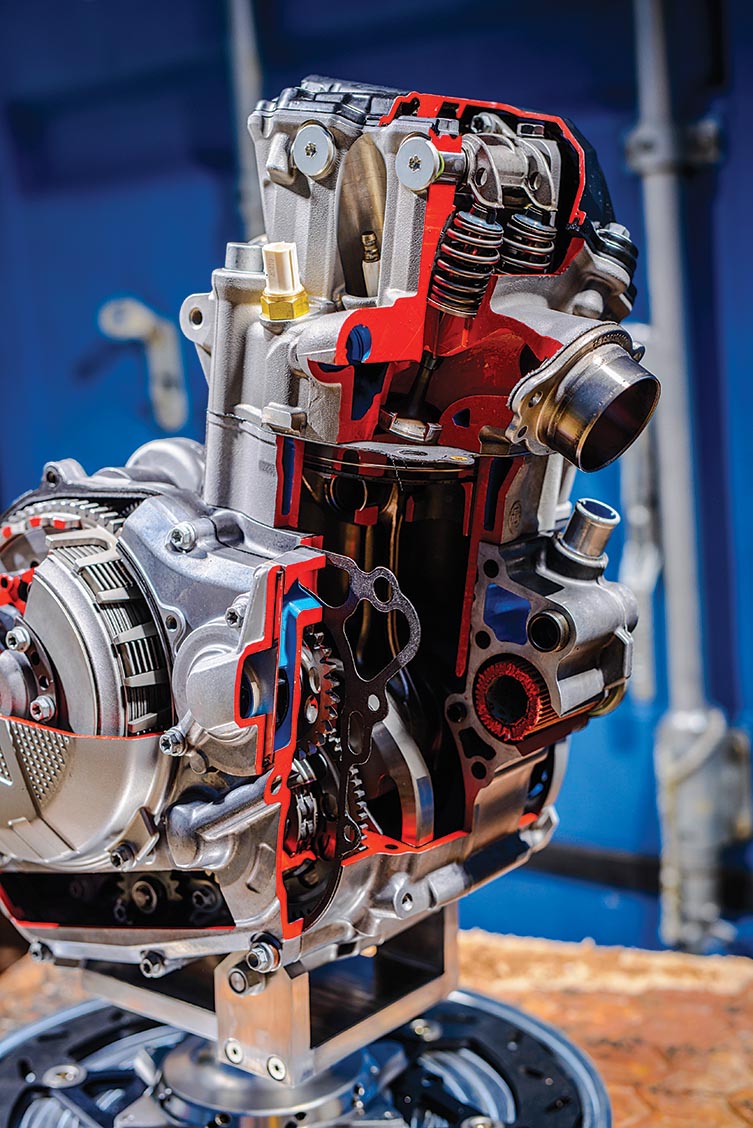
KTM’s four-strokes are made up of 378 parts, 365 of which are new for 2016. So, to get a feel for how these radically different, new generation MX models compare to their predecessors on the track, we sampled the new MX range at the recent media launch in the USA.
Hypothetically, if you built the best engine, the best frame, the best suspension and the best ergonomics, then combining those four elements would automatically produce the best motorcycle, right? Well, according to KTM’s designers, that rationale doesn’t necessarily hold true. They subscribe to Aristotle’s notion that the whole can be greater than the sum of its parts – but only if those parts are designed and refined in a harmonious way. And they are adamant their 2016-model MX machines are testament to that philosophy. More specifically, KTM says this design synergy has much do with the fact that, in the quiet little township of Mattighofen, their design teams tend to work and play together, and that their most fruitful design ideas materialize during trailrides or boozy Sunday arvo barbeques. Whatever the case, the development process is clearly working for them.
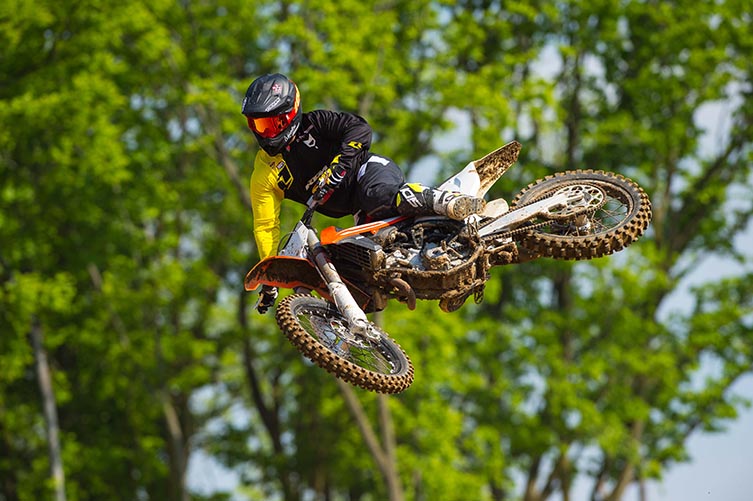
KTM’s 2016 models (in 2015 Factory Edition guise, anyway) have already claimed two 2015 AMA Supercross titles, and both the 250SX-F and 450SX-F lead their class standings in the AMA Outdoor Nationals as we go to print on this issue. So, all KTM now needs to do is convince the broader consumer market that their totally revamped 2016-model production bikes represent a quantum leap over their predecessors and, more to the point, better value for money than their Japanese rivals. To get a sense for how KTM’s sweeping mods actually translate into changes in the bikes’ performance and feel, we threw a leg over the 2016 machines at Indiana’s Ironman Raceway, and then spoke to the key KTM people behind the new-gen range’s design and development.
“Of all the engines, the 350 feels to have made the biggest step forward. For the first time ever, its power now feels more akin to a 450 than a 250.”
2016 BUZZWORDS
At any product launch, the central theme of what’s being ‘sold’ generally comes gift-wrapped in the form of repetition. Aside from KTM’s mantra that these “radically new” 2016 bikes are “lighter, stronger, more powerful and handle better” – as a direct result of this year’s obsession with reducing weight and centralising mass – there’s also a recurring reference to “comfort”. It might sound more like a sales pitch for a four-wheeled family saloon than a state-of-the-art motocross weapon, but rider comfort is the reason behind the 2016 bikes’ new seat, new rubber-mounted bars and overhauled bodywork. It’s also the impetus for their focus on reducing vibration on all models.
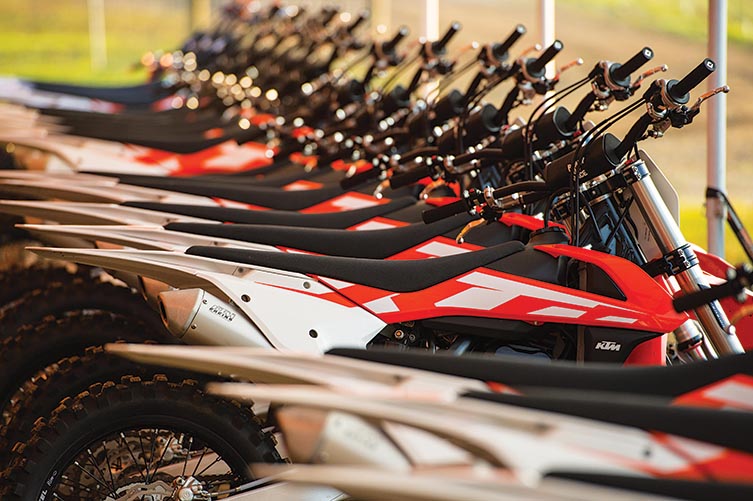
In other words, all four contact points with the new bikes (hands, bum, feet and knees) have been refined to create a more contented, relaxed rider. Which makes a lot of sense. After all, who likes riding a bike that beats up your hands, leaves bunions on your arse, vibrates the bejesus out of your feet, and makes it difficult to grip with your knees?! So, how has KTM achieved this overriding goal of improving rider comfort? And has it come at the cost of performance or reliability? Time to hit the track…
IN THE COCKPIT
Given that all SX and SX-F models now run identical frame geometry, fuel tank and bodywork, it’s near impossible to tell one from the next when you sit on the things with your eyes closed. But they are noticeably different to the 2015 bikes, and the lower seat-height is the most obvious change for 2016. You can now almost get both feet flat on the ground while seated, but because the handlebars and footpegs are also lower (10mm and 5mm, respectively), the seat/bars/peg triangle remains largely unchanged, albeit 10mm closer to the ground. The revised rider position is a win-win in the sense that shorter riders will like the extra control the lower seat gives them through ruts and in slick conditions, and yet it won’t cramp taller guys for legroom. With more padding and a rounder profile, the 2016 seat is noticeably gentler on your arse, but it’s also much flatter this year. This ensures the cockpit retains its racy feel and, combined with the much more streamlined bodywork (which seems to have taken its lead from the new gen Hondas), it’s easier than ever to shift your weight back and forward on the bikes.
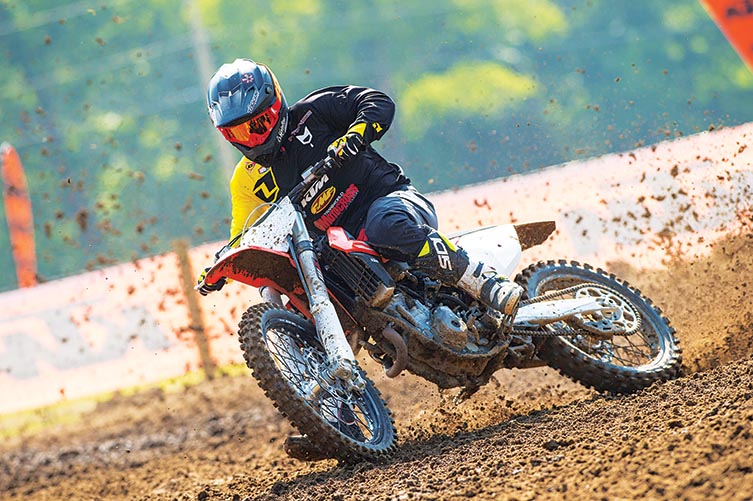
KTM says the bikes are slightly slimmer through the tank and shrouds, but it’s not discernible. In the standing position, however, the added girth through the side-plates does give your legs more to grip onto (a mod that desert racers in particular will love), while the new rubber-damped bar-mounts absorb vibration and make for a more refined feel through your hands. Same goes for your feet. No, the footpegs are not rubber-mounted, but by relocating the engine mounts to the side of the new frame for 2016, KTM has managed to minimise the transfer of engine vibration to the pegs. And to our way of thinking, the new ODI lock-on grips are a great practical addition – unless, of course, you’re one of those whack-jobs who claim you’ve grown accustomed to different-sized grips for left and right hands (in which case, simply whip the lock-on units off, and then spend an eternity with your beloved grip glue and safety wire to fit a ‘conventional’ set!). So, yes, the 2016-model Katos tick several boxes when it comes to improving rider comfort. And we can’t help but like the stylish looks of the new minimalist, angular plastics and graphics.
POWER DELIVERY
“The redesigned shock absorber/linkage/swingarm arrangement creates the most sure-footed rear-end ride we’ve ever felt from a KTM.”
The bore and stroke configurations for all engines may be unchanged for 2016, but the powerplants are otherwise completely new. Without access to a dyno or last year’s bikes to make a direct comparison at the launch, we’ll have to take KTM’s word for it that the 2016 engines all generate more outright power. What we can definitively say after testing the bikes, though, is that the 2016 models all produce broader and more usable power. Noticeably more! That’s particularly good news for the 250SX-F – a machine that has never been shy of top-end grunt, but has slipped behind the rest of the quarter-litre MX bike rat-pack in the past couple of years when it comes to torque and throttle response at lower revs. The 2016 250SX-F donk gets into the meat of its power earlier in the rev range, but gives away nothing through the mid-range and top-end.
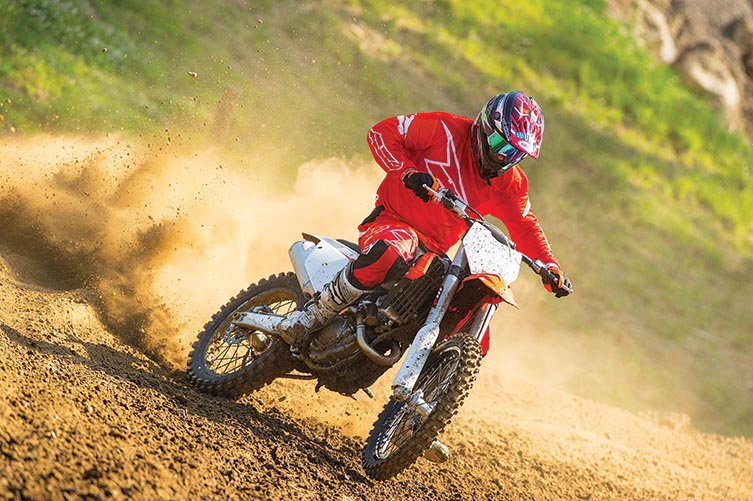
Given that the 350SX-F uses the same powerplant platform, it’s no surprise that it also makes significant power gains at lower revs. In fact, of all the engines, the 350 feels to have taken the biggest step forward. For the first time ever, its power now feels more akin to a 450 than a 250. The 350SX-F can now be short-shifted and rear wheel-steered almost as readily as last year’s 450SX-F. It can still be ridden like a bat-out-of-hell 250 if you like, but its broader power for 2016 means you no longer have to ride it like that. And that’s going to make the thing much more attractive for anyone questioning whether they’ve got the strength and stamina to stay on top of a 450’s sheer mumbo for an entire moto. With a claimed 62hp at the crank – that’s four ponies up on last year’s prodigious 450cc engine – the 2016 450SX-F powerplant sounds intimidating on paper. But all that disappears the second you open the taps on the thing. In place of the free-revving, eye-wateringly explosive mid-range that characterised the 2015 engine, the 2016 bike is super smooth and deceptively fast. Dare we say it, this donk has taken a leaf out of the YZ450F’s book. Dial in the juice in third gear and it’ll effortless carry its front wheel 20cm off the turf, easy as you like. It won’t wheelstand wildly out of slow ruts, nor step-out unpredictably around flat sweepers. It delivers a seamless surge of manageable grunt through the entire rev range and gets its power to ground very, very effectively.
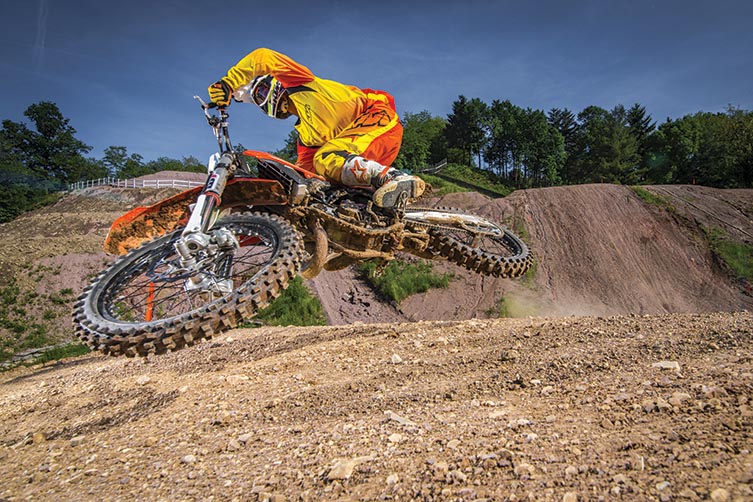
Compared to its predecessor, it’s much easier to ride for less experienced riders, though we suspect Pro guys will perform pipe and/or mapping mods to give them that super responsive mid-range they all seemed to love about the 2015 engine. What’s not so user-friendly, however, is KTM’s all-new Launch Control mechanism. Sure, it’s easy to engage (by flicking the new bar-mounted dual-map switch back and forth) and the flashing light clearly signifies that it’s activated. The problem is, it disengages the instant you blip the throttle – which, let’s face it, is an occupational hazard for a nervous racer on a startline. To ensure the special starting map remains activated, you can only turn the throttle once – when you hold the thing against the stops, ready to drop the clutch. Once you get the procedure down pat, though, it works a treat. With the rev limiter lowered (to 9000rpm for the 450, and to 10,500rpm for the 250/350), you simply hold the throttle wide open and feed it some clutch, and you fire out of the gates like a rocketship.
CHASSIS FEEL
Much has been made of ‘mass centralisation’ and its handling benefits in recent years, but KTM has been conspicuously quiet on that front. Until now, that is. KTM’s 2016 bikes have embraced the concept with two hands, and there’s no doubt it has paid dividends with the new models’ agility. While shaving 3-4kg off the bikes’ weight, and mods such as the shorter subframe, steeper steering head and shorter wheelbase, all help to improve chassis agility, it’s the overhauled engine configurations that have had the biggest impact on the character of the new bikes’ ride.
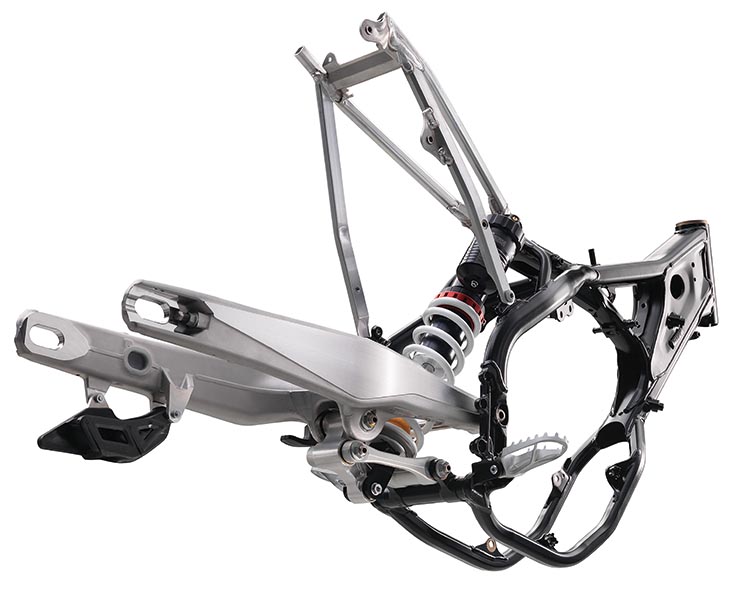
By relocating the axis of the crank and clutch shafts (predominantly up on the two-strokes, and up and back on the four-strokes) toward a more central position, the gyroscopic effect of all engines has been reduced drastically for 2016; the result of which is that the engines now have less affect on the bikes’ handling and ability to change direction. The 2016 machines can be flicked from side to side through chicane-style turns or thrown around in the air with noticeably less rider input. That creates a more neutral and lighter feel to the chassis, which makes the bikes less fatiguing to ride for long periods.
REVAMPED SUSPENSION
“The revised settings on the 4CS fork make it much plusher and more progressive on the smaller bumps, but it’s lost some bottoming resistance for 2016, too.”
KTM got the rear-end of their 2015 MX models working really well, but we weren’t fans of the move from the twin-chamber to the 4CS fork last year. The firm valving settings that were used to prevent the 4CS fork from bottoming also made the thing harsh in the mid-stroke, and that really affected the ride and chassis balance in certain circumstances. Thankfully, KTM and WP have worked hard on improving the progression of the 4CS fork’s action for 2016. Spring rates remain unchanged across the new range, but the valving specs are significantly different. The net result is that the 2016 fork delivers a much more supple ride over the smaller bumps and square-edged hits. The fork sits up in its stroke better on the way into turns or when you’re hard on the picks, and this lets you make inside lines without washing the front.
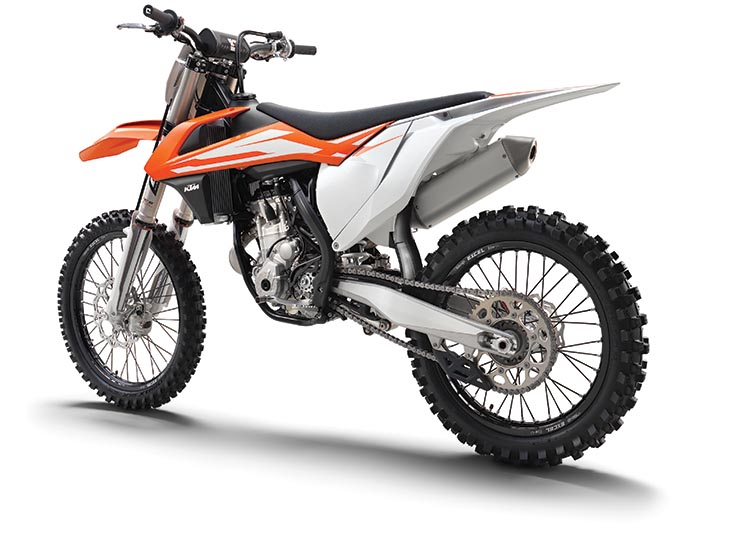
In the mid-corner, it settles and squats nicely, gives you plenty of feedback and lets you carry more corner speed. But, and this is a big but (for Prolevel riders, anyway), that forgiving nature over the smaller bumps has come at a cost on the bigger hits, where the 2016 4CS uses all of its stroke, and then some! If you slam an up-ramp, hit a G-out, or accidentally over-jump a down-ramp, you soon discover the 2016 fork has less bottoming resistance than last year’s fork. The 450SX-F, in particular, bottoms easier than most, if not all, of its class rivals. And that’s unusual for a fork that’s been developed specifically for the American market, where riders lean more toward firmer, SX-style fork settings. If you listen to what long-time test rider, Mike Sleeter, says in the From the Test Pilot sidebar below (about KTM’s aim of creating a more comfortable ride for the average rider), then you could interpret that to mean KTM has taken the edge of its “Ready To Race” mantra for 2016. Sure, the designers are right in saying that serious racers will all get their suspension re-valved anyway, but quick guys generally like to finetune their fork to suit their riding style, not out of absolute necessity. With the 2016 KTMs, even 70-75kg Pro-level riders will not be able to race confidently on the standard suspension – at least, not on the 4CS fork on a rough track. The all-new WP shock absorber, however, performs flawlessly for punters and Pros alike, on big bumps or small.
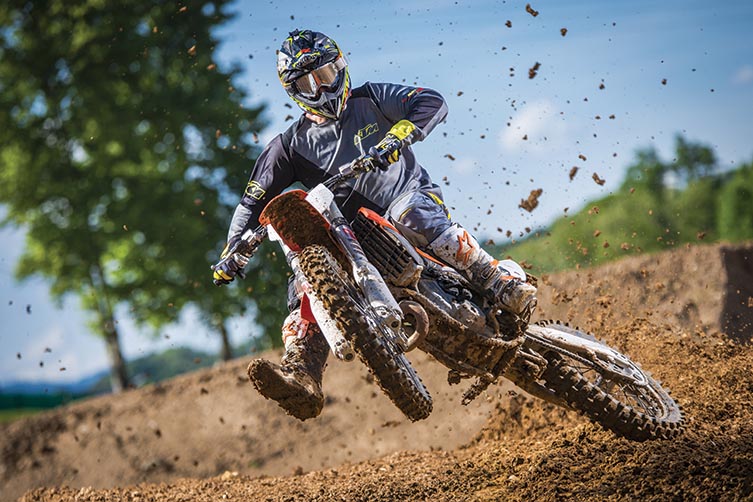
The new linkage – developed to work in harmony with the all-new frame, all-new shock absorber and revised swingarm – puts less emphasis on the shock’s spring and valving settings. And that creates a more forgiving action that works over a wider variety of terrain. The 2016 bikes’ rear-ends are superb on both acceleration and braking bumps. Whether you’re hitting rollers or square-edged bumps, the rear wheel stays in contact with the ground more often. The bikes track straighter over a series of acceleration bumps (no doubt, assisted by the smoother power delivery all models have found for 2016), but we reckon the biggest gains are made in the chassis’ predictability on the way into turns. No matter how big and nasty the braking bumps, the 2016 bikes’ rear-ends retain a more planted, composed feel, meaning they’re less inclined to be knocked off-line unexpectedly.
THE TWO-BANGERS
Given the sweeping mods to engine, frame and bodywork on the three newgen four-strokes, it would have been understandable if Kato’s two-stroke range took a back seat in the mod department this year. Well, the 250SX did, but KTM’s venerable little 125SX sure didn’t. Despite the fact it’s been the clear standout in its class for some time, the 125SX hasn’t copped what you’d call a major overhaul for a few years now. So, that’s precisely what it got for 2016, no doubt prompted also by the growth in significance of the European 125cc MX Championship (EMX125).
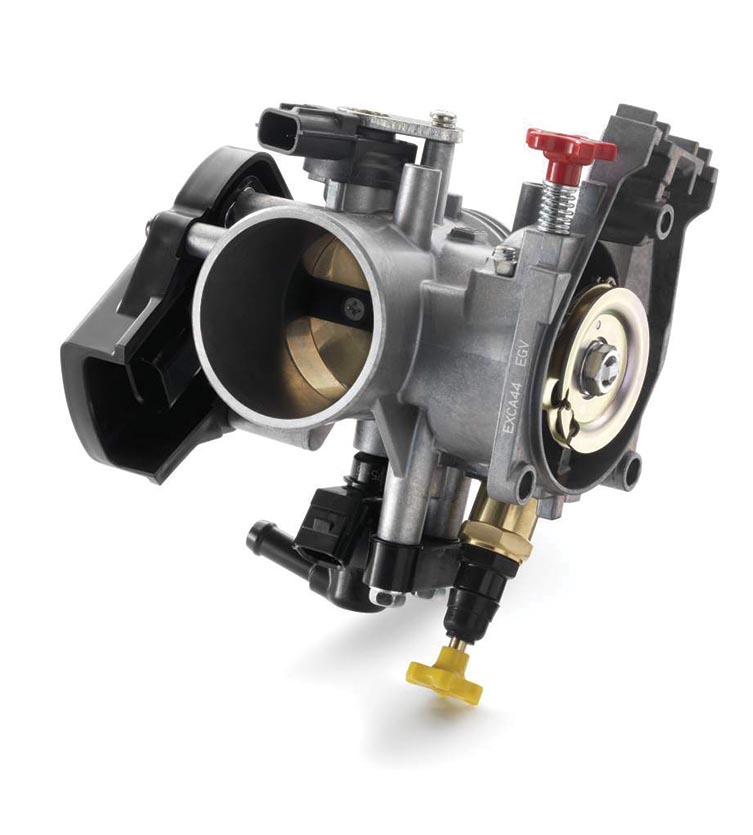
The new 125SX looks completely different (the 2016 engine is so compact, it could almost pass for an 85!) and feels like a very different machine to ride, too. The all-new engine delivers big gains through the bottom and mid, without giving away any top-end power, while the lightweight little machine benefits even more than the four-strokes from the more forgiving nature of the revised frame and 4CS fork. But why overlook the 250SX completely for 2016? As Jochi Sauer explains in the Design Philosophy and Lineage sidebar on page 62, KTM’s 2016 machines have all been developed as an overall package, so it made no sense to adapt the 2016 frame and bodywork package to an existing engine.
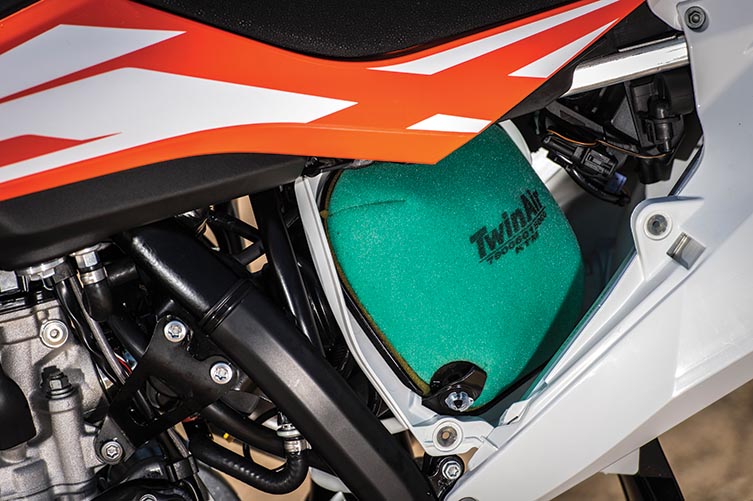
Remember also that the 250cc two-stroke doesn’t sell elsewhere in the world like it does in Oz and New Zealand, so there was little motivation for KTM to overhaul it. That said, we can’t imagine the entire look of the 250SX will remain at odds with the rest of the range for too long. And given that KTM isn’t going to adapt the new-generation frame and bodywork specifically for this one model, we’d expect a revamped 250cc two-stroke engine to appear from KTM in 2017.
TAKING STOCK
Admittedly, KTM is intent on staying ‘on-message’ when referring to their 2016 MX models as “radically new” and “new-generation”, but those descriptions are no exaggeration. In fact, Jochi Sauer, the head of KTM’s product development department for 30 years, claims these models represent “by far the biggest off-road development project in KTM’s history”. Every single machine is appreciably lighter and more agile, and they all come with broader and more usable power.
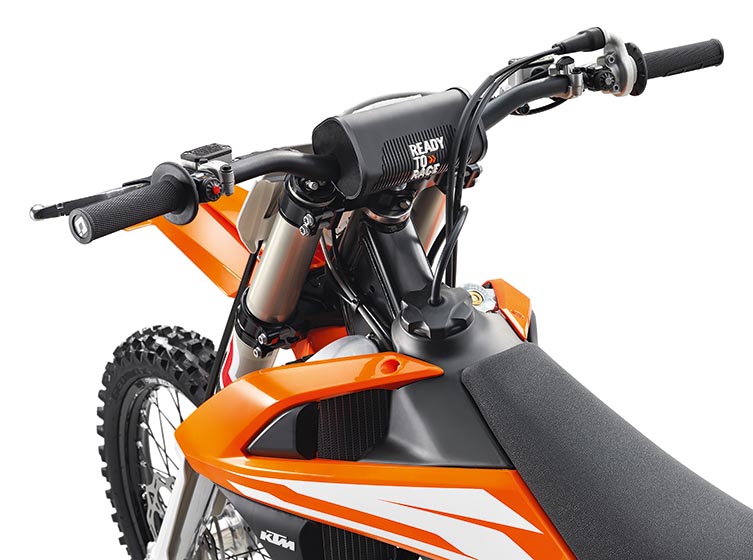
The mods to bodywork and ergos are both practical and goodlooking, and the redesigned shock absorber/linkage/swingarm arrangement creates the most sure-footed rear-end ride we’ve ever felt from a KTM. Our only question mark with the new machines is the revised 4CS fork settings, so it’ll be great to spend some more time with the bikes once they arrive in Oz. According to KTM Australia, the 2016-models will be in Aussie dealers by early September, with pricing expected to be in line with the 2015 bikes.
Related Content

TESTED: KTM’S 2019 MX RANGE
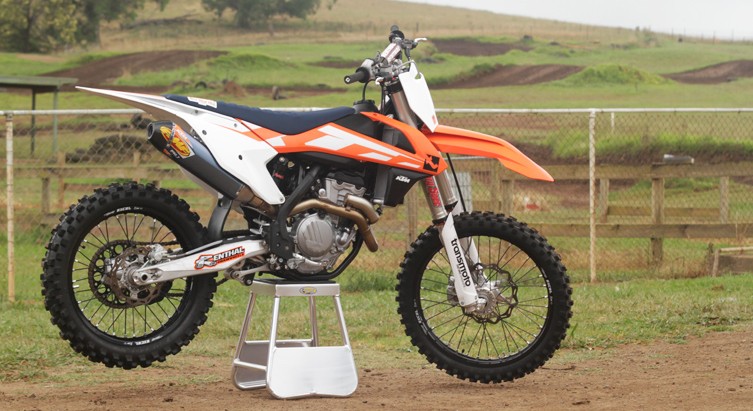
2016 KTM 350SX-F: SUSPENSION MODS
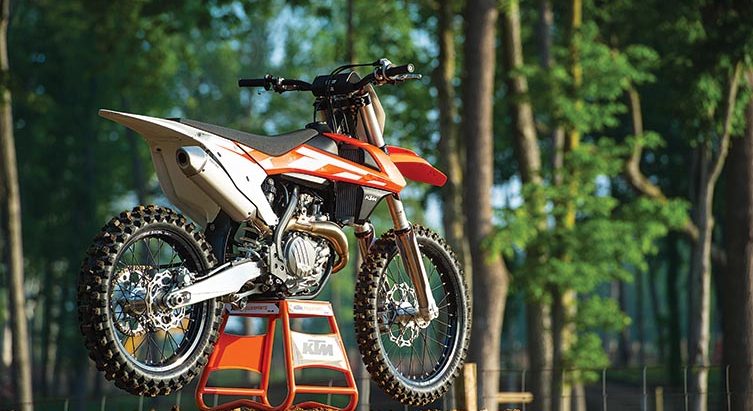


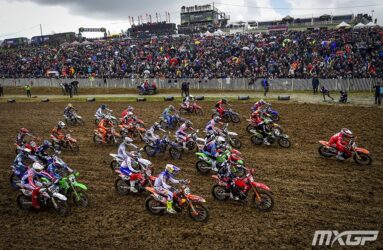


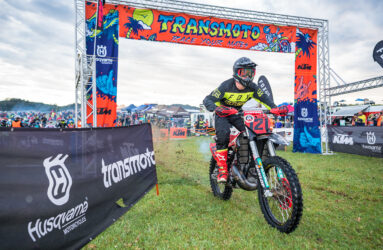


Be the first to comment...